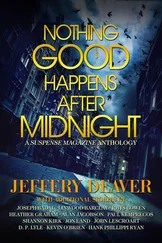And get down to doing what I was born to do.
The setup was this:
One sniper and her spotter, across the street from the Locksmith’s suspected workshop, the old Sebastiano Bakery Supply building.
One surveillance team in a battered florist delivery van with eyes and ears on the place.
One four-person dynamic entry team south, one north, each a half block from the front door. They were inside, respectively, a plumbing repair truck and an unmarked but highly battered white van, not unlike the one that played a two-ton prop in Sachs’s dramatic film debut earlier, directed by undercover cop Aaron Douglass.
And out of sight, ambulances and a squadron of uniforms. A fire truck too, given the Locksmith’s attempt at destroying the evidence in the Sandleman Building.
Sachs spoke into her cell phone. “We’re on location, Rhyme.”
“Any sign of him?”
“Nothing. Windows’re shuttered. Only one functioning door in and out, the front. The delivery entrance, in the back. It’s been bolted shut. There’ll be a small cellar with a coal chute. That door’s been sealed too.” She was looking over a photo from the Department of Buildings that showed the layout of the place. New York City records were very much as old as New York City. “Thinking if he spots us he could rabbit through adjoining basements, but he’d have to break through the walls — no adjoining doors. They’re brick and sandstone. Anyway, we have eyes on the neighboring structures too.”
Rhyme would normally have been on the radio, the frequency that was used for operations like this. But, of course, he was in NYPD purgatory. He’d have to find out about the operation after it was completed.
“You going in?”
“Yep. The north team.”
He would know that that crew was going in first, and that Sachs, among the four, would be in the lead.
He wouldn’t ask if she didn’t want to leave the cowboy stuff to ESU, younger and most with military training. It would be like asking Rhyme if he was sure he wanted to spend another hour or two or three analyzing a smidgeon of trace that, somehow, might hold the key to identifying a perp.
“K. Let me know.”
They disconnected.
Then Sachs, in helmet and full body armor, was out of the van, and with the three members of her team was moving low along the sidewalk to the front door of the baking supply company. The south team approached too and would go through the door after the north.
Using hand signals only, Sachs directed the fourth member of her team — the breacher — to the door, while the others covered him. Unlike at the Whittaker apartment, they would here be using full-on C4 charges, on the hinges and on the three locks. They were formidable and new, certainly not the make and model that deterred burglars one hundred years ago.
The breacher approached silently and placed the sticky-backed charges beside each hinge and a larger one on the locks, then he backed away ten feet and hefted a battering ram in case the explosions did not completely knock down the door. Sachs nodded to the woman beside her — Sanchez stenciled on her tac vest — and they both front slung their Heckler & Koch MP5 assault rifles and pulled flash-bangs from their belts.
Speaking softly — the mikes were in low-volume-pickup mode — Sachs said, “Sniper?” She looked across the street and up, noting that the woman and her spotter were well hidden and the barrel of the Remington 700P .308 was not visible.
“In position, covering. No sign of movement.”
“Roger. South team?”
They were only thirty feet away and rather than respond verbally, that team leader lifted a thumb.
Sachs felt her heart thud and she was filled with exhilaration. Two things brought her unlimited joy: driving on the edge, engine wailing, and the instant before a dynamic entry.
She gave the hand signal to all the troops to hunker down for the bang, then held up three fingers of her left hand. She tucked them away one by one. As the last curled into a fist, the breacher whispered, “Fire in the hole,” and sent the signal to the plastic charges. Five simultaneous explosions shook the ground beneath them, as the door splintered and crashed inside. No ram would be necessary.
First Sachs, then Sanchez pulled the grenade pins and pitched them inside.
A few seconds later, when they detonated, Sachs and her trio, followed by the south team charged forward, muzzles swiveling up and down out of one another’s way, as the tactical halogens affixed beneath the machine guns’ muzzles swept the dim place. “Police, police, police!”
The officers fanned out in the large room, which appeared unoccupied.
There were some storage areas and a bathroom. Officers cleared them fast.
She looked around. There was no doubt it was the Locksmith’s workshop. There had to be a hundred locks on the wall. Machinery too, and the key-making machine that she and Rhyme speculated he had. Books and papers. No computers, phones or tablets were visible, but they might be in drawers — or, she thought angrily, with him in a different location.
An apartment elsewhere, probably. There was a bed and a small kitchen but this didn’t seem a full-time residence.
“Breach successful,” she called into the radio. “Negative on suspects, main floor. Breaching cellar.”
In the floor was a trapdoor. As she’d thought before, it would be an unlikely escape route for him, but maybe he had found one of the old tunnels that latticed this part of town, to move goods underground from one company to another. None were shown on the city maps that she’d examined but they often weren’t.
The north team walked to the trapdoor. Sachs sighed. She hated clearing cellars.
“Away from the door. In case he rigged it.”
The officers stepped back. Sachs gripped the rope used to lift the door and, moving as far away as she could, yanked the heavy, three-foot square of wood up.
No explosions, no gunshots.
She and Sanchez stepped forward, staring down into the darkness, illuminated by their tactical halogens. She saw only disintegrating concrete and brick. “Police! If anyone’s down there, show yourself.”
Nothing appeared but leisurely dust motes.
“Camera.”
An ESU officer named Brill pulled from his belt the same model of camera that had been used in Whittaker’s apartment. He fed the lens through the trapdoor opening and clicked the unit to night vision. A three-hundred-and-sixty-degree scan showed trash bags and boxes, stacks of wood, a few pieces of rusting machinery whose purpose she couldn’t deduce.
“I count five instances of cover,” Brill said. “Boxes and the trash west and north and east corners. And the coal bin in the back.”
“Agreed.”
Brill substituted his camera for his machine gun.
Pulling another flash-bang off her tactical belt, Sachs said, “I’m going down.”
She glanced at Sanchez’s belt. The woman front slung then nodded and lifted off a grenade as well.
“Two each, quadrant them.”
If the Locksmith were below, he’d be hiding far away from the trapdoor. They’d fling the devices toward the corners of the cellar.
The woman nodded.
“One final chance. Show yourself!” When there was no response, Sachs tossed her first grenade then stepped back as Sanchez threw hers. As they were greeted with two loud cracks, they repeated the choreography, targeting the two remaining corners.
Sachs glanced down and drew her Glock, set her foot on the top rung of the stairs.
She stopped.
Jesus...
“Back, back!”
She clambered to the main floor, stumbling onto her side, and scrabbling away as a swirling cloud of flame shot from the opening and into the air, ten feet.
Читать дальше
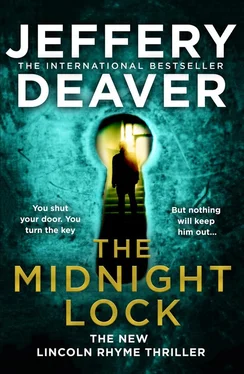
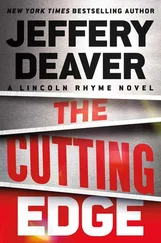





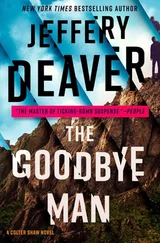
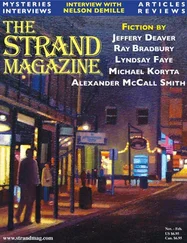
![Джеффри Дивер - Where the Evidence Lies [A Lincoln Rhyme Short Story]](/books/403782/dzheffri-diver-where-the-evidence-lies-a-lincoln-r-thumb.webp)


